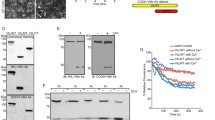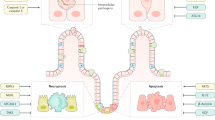Abstract
The small intestinal epithelium is continuously renewed through a balance between cell division and cell loss. How this balance is achieved is uncertain. Thus, it is unknown to what extent programmed cell death (PCD) contributes to intestinal epithelial cell loss. We have used a battery of techniques detecting the events associated with PCD in order to better understand its role in the turnover of the intestinal epithelium, including modified double- and triple-staining techniques for simultaneously detecting multiple markers of PCD in individual cells. Only a partial correlation between TUNEL positivity for DNA fragmentation, c-jun phosphorylation on serine-63, positivity for activated caspase-3 and apoptotic morphology was observed. Our results show that DNA fragmentation does not invariably correlate to activation of caspase-3. Moreover, many cells were found to activate caspase-3 early in the process of extrusion, but did not acquire an apoptotic nuclear morphology until late during the extrusion process. These observations show that the lack of consensus between different methods for detecting PCD may be explained both by different timing of appearance of PCD markers and, additionally, by the occurrence of different forms of PCD during the normal turnover of cells on small intestinal villi.



Similar content being viewed by others
References
An S, Hishikawa Y, Koji T (2005) Induction of cell death in rat small intestine by ischemia reperfusion: differential roles of Fas/Fas ligand and Bcl-2/Bax systems depending upon cell types. Histochem Cell Biol 123:249–261
Cao BH, Mortensen K, Tornehave D, Larsson LI (2000) Apoptosis in rat gastric antrum—regulation by food intake depends upon nitric oxide synthase. J Histochem Cytochem 48:123–131
Chandrasekaran C, Coopersmith CM, Gordon JI (1996) Use of normal and transgenic mice to examine the relationship between terminal differentiation of intestinal epithelial cells and accumulation of their cell cycle regulators. J Biol Chem 271:28414–28421
Derijard B, Hibi M, Wu LH, Barett T, Su B, Deng T, Karin M, Davis RJ (1994) JNK1: a protein kinase stimulated by UV-light and Ha-Ras that binds and phosphorylates the c-Jun activation domain. Cell 76:1025–1037
Fischer U, Jänicke RU, Schulze-Osthoff K (2003) Many cuts to ruin: a comprehensive update of caspase substrates. Cell Death Differ 10:76–100
Frisch SM, Francis H (1994) Disruption of epithelial cell-matrix interactions induces apoptosis. J Cell Biol 124:619–626
Gavrieli Y, Sherman Y, Ben-Sasson SA (1992) Identification of programmed cell death in situ via specific labeling of nuclear DNA fragmentation. J Cell Biol 119:493–501
Groos S, Reale E, Luciano L (2003) General suitability of techniques for in situ detection of apoptosis in small intestinal epithelium. Anat Rec 272A:503–513
Grossmann J, Walther K, Artinger M, Rummele P, Woenckhaus M, Scholmerich J (2002) Induction of apoptosis before shedding of human intestinal cells. Am J Gastroenterol 97:1421–1428
Ip YT, Davis RJ (1998) Signal transduction by the c-Jun N-terminal kinase (JNK)—from inflammation to development. Curr Opin Cell Biol 10:205–219
Jäättelä M (2004) Multiple cell death pathways as regulators of tumour initiation and progression. Oncogene 23:2746–2756
Jänicke RU, Sprengart ML, Wati MR, Porter AG (1998) Caspase-3 is required for DNA fragmentation and morphological changes associated with apoptosis. J Biol Chem 273:9357–9360
Jones BA, Gores GJ (1997) Physiology and pathophysiology of apoptosis in epithelial cells of the liver, pancreas and intestine. Am J Physiol 273:G1174–G1188
Karin M (1995) The regulation of AP-1 activity by mitogen-activated protein kinases. J Biol Chem 270:16483–16486
Kerr JF, Wylie AH, Currie AR (1972) Apoptosis: a basic biological phenomenon with wide-ranging implications in tissue kinetics. Br J Cancer 26:239–257
Larsson LI (1988) Immunocytochemistry: theory and Practice. CRC Press, Boca Raton
Larsson LI (2004) Novel actions of tyrphostin AG 879: inhibition of RAF-1 and HER-2 expression combined with strong antitumor effects on breast cancer cells. Cell Mol Life Sci 61:2624–2631
Le-Niculescu H, Bonfoco E, Kasuya Y, Claret FC, Green DR, Karin M (1999) Withdrawal of survival factors results in activation of the JNK pathway in neuronal cells leading to Fas ligand induction and cell death. Mol Cell Biol 19:751–763
Lockshin RA, Zakeri Z (2004) Caspase-independent cell death? Oncogene 23:2766–2773
Potten CS, Allen TD (1977) Ultrastructure of cell loss in intestinal mucosa. J Ultrastruct Res 60:272–277
Schauser K, Olsen JE, Larsson LI (2005) Salmonella Typhimurium infection in the porcine intestine: evidence for caspase-3-dependent and -independent programmed cell death. Histochem Cell Biol 123:43–50
Tornehave D, Hougaard DM, Larsson LI (2000) Microwaving can be used to mask endogenous and exogenous immunoglobulins: protocols for multiple stainings with primary antibodies from the same species and for staining of mouse tissues with mouse monoclonal antibodies. Histochem Cell Biol 113:19–23
Watson AJM, Pritchard DM (2000) Lessons from genetically engineered animal models VII. Apoptosis in intestinal epithelium: lessons from transgenic and knockout mice. Am J Physiol 278:G1–G5
Wilson JW, Potten CS (2004) Cell turnover: intestine and other tissues. In: Lockshin RA, Zakeri Z (eds) When Cells Die II. Wiley, Hoboken, pp 201–240
Xie Z, Dickens M, Raingeaud J, Davis RJ, Greenberg ME (1995) Opposing effects of ERK and JNK-p38 MAP kinases on apoptosis. Science 270:1326–1331
Yang D, Kuan CY, Whitmarsh AJ, Rincon M, Zheng TS, Davis RJ, Rakic P, Flavell RA (1997) Absence of excitotoxicicty-induced apoptosis in the hippocampus of mice lacking the JNK3 gene. Nature 389:865–870
Acknowledgements
Grant support was from the Danish MRC, FTP, Cancer Society and the Lundbeck foundation.
Author information
Authors and Affiliations
Corresponding author
Rights and permissions
About this article
Cite this article
Schauser, K., Larsson, Li. Programmed cell death and cell extrusion in rat duodenum: a study of expression and activation of caspase-3 in relation to C-jun phosphorylation, DNA fragmentation and apoptotic morphology. Histochem Cell Biol 124, 237–243 (2005). https://doi.org/10.1007/s00418-005-0035-7
Accepted:
Published:
Issue Date:
DOI: https://doi.org/10.1007/s00418-005-0035-7




